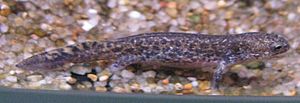Clouded Salamander facts for kids
Quick facts for kids Clouded Salamander |
|
|---|---|
 |
|
| Conservation status | |
| Scientific classification | |
| Kingdom: | |
| Phylum: | |
| Class: | |
| Order: | |
| Family: | |
| Genus: |
Hynobius
|
| Species: |
H. nebulosus
|
| Binomial name | |
| Hynobius nebulosus (Temminck & Schlegel, 1838)
|
|
The Clouded Salamander (Hynobius nebulosus) is a fascinating type of salamander that belongs to the Hynobiidae family. These amazing creatures can only be found in Japan. They love living in warm forests, near rivers, in swamps, and around freshwater springs. They also enjoy areas where land is being watered, showing their need for moist environments.
Contents
Meet the Clouded Salamander
Clouded Salamanders are small, secretive amphibians. They are part of a group of animals that can live both on land and in water. Like all amphibians, they have smooth, moist skin. Their name, "clouded," likely comes from their skin pattern, which might have spots or blotches that look like clouds.
Where Do They Live?
These special salamanders are native only to Japan. They prefer habitats that are wet and cool, which is typical for many amphibians. You can find them in:
- Warm forests, where they hide among leaves and logs.
- Near rivers and streams, where they can find water easily.
- Swamps and freshwater springs, which provide the damp conditions they need.
- Even in areas where land is being watered, showing their adaptability to human-influenced moist spots.
What Do They Eat?
Clouded Salamanders are carnivores, meaning they eat other small animals. They are important predators in their tiny ecosystems. Their diet usually includes:
- Small insects, like ants and beetles.
- Spiders and other small invertebrates.
- Worms and slugs.
They use their quick tongues to catch their prey.
Life Cycle of a Salamander
The life of a Clouded Salamander, like other amphibians, involves a cool transformation called metamorphosis.
- Eggs: Female salamanders lay their eggs in water, often attached to plants or rocks. These eggs are usually in a jelly-like mass.
- Larvae: When the eggs hatch, tiny larvae emerge. These larvae live in the water and look a bit like tadpoles, but with feathery gills on the outside of their heads for breathing underwater.
- Adults: As they grow, the larvae lose their gills and develop lungs, allowing them to breathe air. They also grow legs and change into their adult form, ready to explore both land and water.
Why Are They Important?
Clouded Salamanders play a vital role in their environment.
- They help control insect populations by eating them.
- They are also a food source for larger animals, like birds and snakes.
- Their presence can indicate a healthy ecosystem, as they need clean water and undisturbed habitats to survive.
See also
 In Spanish: Aneides ferreus para niños
In Spanish: Aneides ferreus para niños


